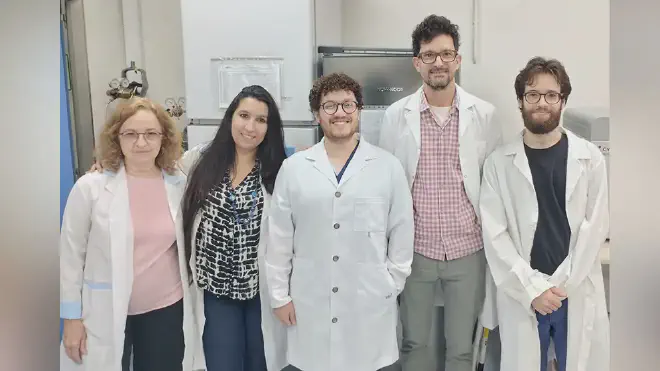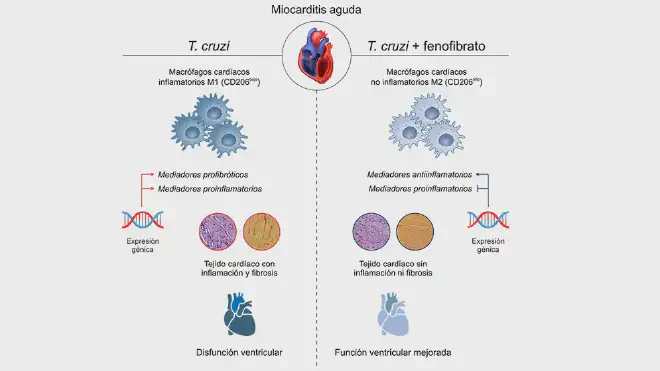
A drug called fenofibrate, which is used in medical practice to lower triglyceride and cholesterol levels, improved cardiac function in an experimental model of Chagas disease. The study, led by specialists from CONICET, was published in the journal ACS Infectious Diseases.

“These findings support and reinforce the potential repositioning of fenofibrate as a therapeutic drug complementary to antiparasitics to alleviate, delay, or prevent the cardiac symptoms of this neglected disease,” said Federico Penas, the leader of the work and a researcher at CONICET in the Institute of Biomedical Research in Retroviruses and AIDS (INBIRS, CONICET-UBA). He added: “As a result of our work and previous research, the next step would be to test the therapeutic efficacy of this medication in clinical trials.”
Chagas disease, resulting from the infection of the parasite Trypanosoma cruzi, is the leading cause of dilated cardiomyopathy across the American continent (World Health Organization, 2015). According to the latest consensus on Chagas disease developed by the Argentine Society of Cardiology, in Argentina more than 1,500,000 people suffer from this disease, and over 375,000 present cardiological symptoms (Argentine Society of Cardiology, 2019).

The antiparasitic treatment fundamentally depends on benznidazole, which, while effectively eliminating the parasites, does not improve the cardiac dysfunction caused by the infection and characterized by persistent inflammatory processes. “Taking this context into account, in recent years, our laboratory, led by CONICET researcher Nora Goren, has investigated and deepened in vitro and in vivo studies of a combined therapy that involves not only the antiparasitic benznidazole but also an inflammation-modulating drug like fenofibrate,” said Ágata Cevey, also an author of the work and a CONICET researcher at INBIRS.
“In vitro and in vivo studies” #
In a study published in 2022 in Frontiers in Cellular and Infection Microbiology, the same research team and colleagues conducted in vitro experiments on peripheral blood mononuclear cells from patients with varying degrees of severity of Chagas disease, and found that treatment with fenofibrate increases the proportion of populations of a type of white blood cells towards an anti-inflammatory profile and therefore beneficial for cardiovascular health. This study was conducted in collaboration with the Cardiology services of the Dr. Cosme Argerich General Hospital and the María Ferrer Respiratory Rehabilitation Hospital.
In a study published in 2023, also in the journal ACS Infectious Diseases, the research team from CONICET demonstrated for the first time in an experimental model (mice with Chagas disease) that certain immune system cells, cardiac macrophages, play a fundamental role in the protective effects of fenofibrate on the inflammatory and fibrotic response in the chronic stage of the infection. “We showed that cardiac macrophages are necessary for fenofibrate to improve the ventricular function of infected mice,” Penas pointed out.
In this new study, researchers found that in the animal model of the disease, fenofibrate reduces the activity of enzymes that are markers of tissue damage and decreases the proportion of circulating pro-inflammatory monocytes. “These immune system cells have the ability to internalize into tissues, differentiate into macrophages, and initiate a strong pro-inflammatory response,” explained Penas. And he addsed: “We observe that fenofibrate induces a change in the profile of cardiac macrophages towards an anti-inflammatory or reparative one, resulting in a reduction of fibrosis (changes in the collagen matrix that lead to alterations in cardiac function), inflammation, and an improvement in ventricular function in the early stages of Chagas disease.”
“In the future, we will continue to delve into the mechanisms of action of the combined treatment with benznidazole and fenofibrate in different cell populations,” Penas pointed out. He added that “in parallel, and considering all the described background, we will begin planning a pilot clinical trial that will consist of treatment with fenofibrate and benznidazole for patients with varying degrees of severity of Chagas disease. This trial will have the approval of the Ethics Committees of the participating hospitals.”
For Cevey, “the interesting thing about exploring the use of fenofibrate in patients with Chagas is that this medication has no cardiac adverse effects, making it suitable for prolonged use, and it is also approved by ANMAT, as well as by the main global regulatory entities (FDA, EMA), and is produced by several pharmaceutical laboratories in Argentina.”
Penas concluded that “it is crucial to develop new strategies that are accessible both for the public health system and for patients, in order to prevent the cardiac complications associated with this infection.”
Citations: #
Ruiz Luque, J., Cevey, Á. C., Pieralisi, A. V., Poncini, C., Erra Díaz, F., Azevedo Reis, M. V., … & Penas, F. N. (2024). Fenofibrate Induces a Resolving Profile in Heart Macrophage Subsets and Attenuates Acute Chagas Myocarditis. ACS Infectious Diseases. https://doi.org/10.1021/acsinfecdis.4c00125
Pieralisi, A. V., Cevey, Á. C., Penas, F. N., Prado, N., Mori, A., Gili, M., Mirkin, G. A., Gagliardi, J., & Goren, N. B. (2022). Fenofibrate Increases the Population of Non-Classical Monocytes in Asymptomatic Chagas Disease Patients and Modulates Inflammatory Cytokines in PBMC. Frontiers in Cellular and Infection Microbiology, 11(March), 1–15. https://doi.org/10.3389/fcimb.2021.785166
Cevey, Á. C., Pieralisi, A. V., Donato, M., Rada, J., Gelpi, R. J., Mirkin, G. A., Goren, N. B., & Penas, F. N. (2023). Macrophages Mediate Healing Properties of Fenofibrate in Experimental Chagasic Cardiomyopathy. ACS Infectious Diseases, 9(2), 213–220. https://doi.org/10.1021/acsinfecdis.2c00535

